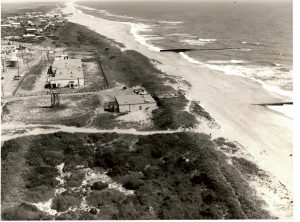
The U.S. Army Corps of Engineers (Corps) issued a press release on Friday, May 3, stating that the contract to remove a pipe that is believed to be a source of petroleum smells and sheens along a closed section of Buxton shoreline has been awarded months ahead of schedule.
According to an April 29 press release, the contract was initially supposed to be awarded by September 2024, with work to begin in late 2024 or early 2025.
However, following an early May visit, the Corps announced on Friday that the removal of the pipe could begin as early as next week.
The three-tenths-of-a-mile closed section of Buxton Beach will not necessarily reopen after the pipe is removed due to additional exposed infrastructure and debris, and the possibility of more than one source of petroleum infiltrating the area.
The full press release from the Corps, which outlines the team’s recent visit to Buxton and communications with the National Park Service and Dare County officials, is as follows:

Leadership from the U.S. Army Corps of Engineers, South Atlantic Division, and the Savannah District conducted a site visit to Buxton, North Carolina, May 1, 2024, to meet with representatives from the National Park Service and Dare County to evaluate current conditions at the Formerly Used Defense Site Buxton Naval Facility and discuss agency and public concerns regarding the reported petroleum contamination. Since the visit, a contract to remove a pipe to determine if it’s the source of the reported petroleum was awarded ahead of schedule.
The Army Corps of Engineers team included Col. Matthew McCulley, South Atlantic Division deputy commander; Col. Ron Sturgeon, Savannah District, commander; Sandy Gibson, South Atlantic Division, Senior Environmental Program manager and Glenn Marks, Savannah District Reimbursable Branch chief.
“I wanted to see the site firsthand, and more importantly, I wanted to meet the agency representatives who live and work here,” said Sturgeon. “I want them to know, even though it’s a slow process, we are making progress, we take this matter seriously and have made it a priority since it was first reported.”
The leadership team was unanimous in voicing their support and acknowledged the slow progress has caused understandable frustration among the community, the National Park Service, and the Dare County officials, and they said they will do more to communicate with the community.
“There are processes and protocols that we are obligated by law to follow,” Sturgeon explained. “The good news is, since our visit Wednesday, a contract has been awarded to remove a potentially contaminated pipe and test the surrounding soil to determine if that’s the source of the reported petroleum, and the contractor plans to visit the site as soon as next week. We are also coordinating dates, times, and locations for regular meetings with the community and our agency stakeholders. This is progress.”
In addition to the contract for the pipe getting awarded and engaging in more communication, a research team from the Environmental and Munitions Center of Expertise is currently doing a deep dive into the site, researching archived facility and real estate records, prior removal and remediation actions undertaken at the site, maps and other information provided to the Army Corps of Engineers that are associated with the site.

While at the former Naval Facility site, the Army Corps of Engineers team met with the National Park Service’s Chief of Resource Management and Science for the Cape Hatteras area, Meaghan Johnson and their Public Affairs Officer, Mike Barber.
Johnson and Barber walked with the leadership team along the 3/10 mile of Buxton Beach and discussed agency concerns, prior weather events that have occurred to date, evaluated the areas of concern, and got a site layout based upon the exposed remnant infrastructure in comparison to historic photos of the area when it was operated by the Navy as a top secret listening post for enemy submarines from 1956-1982. While a few pipes and some structures had recently been covered up by sand again, there were still some visible and the information provided by Johnson and Barber was beneficial.
After visiting with the National Park Service for almost two hours, the Army Corps of Engineers team met with representatives from the Dare County Board of Commissioners and Department of Health and Human Services.
“I’m not pointing fingers at any one agency,” said Bob Woodard, Dare County Board of Commissioners chairman. “We, this board, and the public, feel this is federal property, and it doesn’t matter who cleans it up, it just needs to be cleaned and fast. It’s hard for us to understand why it’s taking so long, and who is taking care of the petroleum, and who is taking care of removing the infrastructure left behind?”
Although the Army Corps of Engineers has a plan to address the potential petroleum contamination, the concern about infrastructure exposed by recent storm erosion is a challenge that cannot be addressed under the FUDS program.

“Now that we have that contract, we will remove and follow the pipe to wherever it leads, because it’s covered under the FUDS Program,” Sturgeon said. “I acknowledge concerns over removing the remaining infrastructure. However, this activity is not authorized under the FUDS Program because it’s not considered an environmental hazard associated with contamination left behind by a former DoD activity.”
Robert Outten, Dare County Board of Commissioners County manager and attorney, wanted to know if the Army Corps of Engineers could help them find a way to get the removal of the infrastructure funded.
“We have reoccurring meetings with our regional, federal partners such as the National Park Service and the Coast Guard,” said McCulley. “We will coordinate with our higher headquarters and our regional federal partners to determine if there’s any existing programs that can be used to remove this infrastructure.”
The Army Corps of Engineers team voiced their willingness to do whatever they could within their authorities and Sturgeon noted he was looking forward to future meetings with not only the stakeholder agencies, but with the community as well. Future meetings are in the works and dates, times and locations will be shared once the details are confirmed.
“We are pleased to learn that the Army Corps of Engineers has identified an authority and funding to remove one of the known sources of petroleum—a rusty pipe that became exposed as a result of erosion events over the past several months,” stated Michael Barber, Public Affairs Specialist for the Cape Hatteras National Seashore, in response to the Corps’ recent press releases. “The pipe, which is located within the Corps’ Buxton formerly used defense site, was sampled in February 2024 by [the] Cape Hatteras National Seashore. The results of two small samples of sand taken from the end of the pipe found petroleum contamination above the state action level.”

“This is a big step in the right direction,” said Brian Harris of the recently established Buxton Civic Association. “The Corps is taking accountability, and we are looking forward to working with them as a community in the future.”
Harris noted that the Buxton Civic Association (BCA) was unaware of the Corps’ recent visit, but that the organization would be attending and sponsoring the upcoming North Carolina Beach, Inlet & Waterway Association meeting on May 9-10 in Emerald Isle, N.C., to further explore and discuss the Buxton Beach issue.
The BCA has also been communicating with Mike McIntyre, attorney and former United States Representative, as well as other organizations including the National Park Service, the North Carolina Coastal Federation, and the Southern Environmental Law Center.
Developing info from the BCA can be accessed via the organization’s new website at Buxtoncivic.com or through the BCA’s official Facebook page at https://www.facebook.com/buxtonnccivicassociation.











